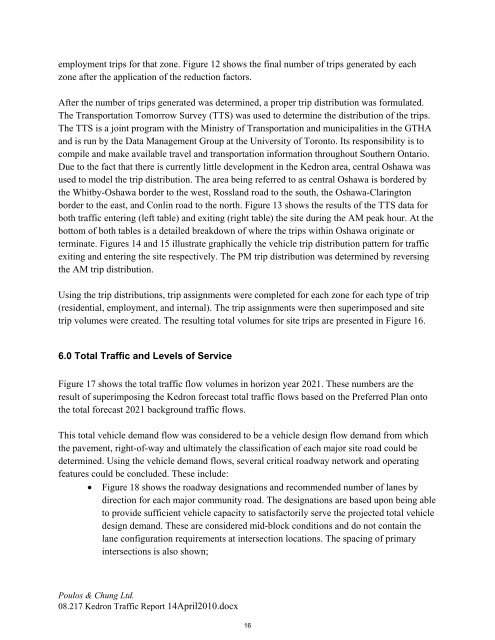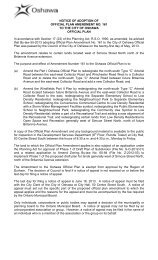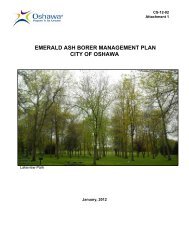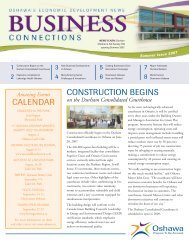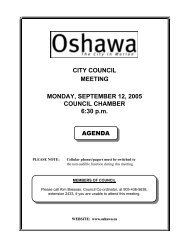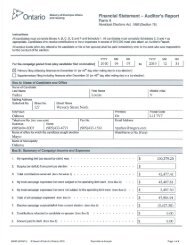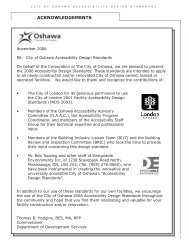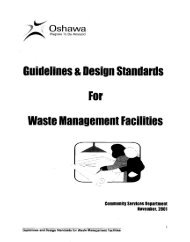Appendix D Transportation Report - City of Oshawa
Appendix D Transportation Report - City of Oshawa
Appendix D Transportation Report - City of Oshawa
Create successful ePaper yourself
Turn your PDF publications into a flip-book with our unique Google optimized e-Paper software.
employment trips for that zone. Figure 12 shows the final number <strong>of</strong> trips generated by each<br />
zone after the application <strong>of</strong> the reduction factors.<br />
After the number <strong>of</strong> trips generated was determined, a proper trip distribution was formulated.<br />
The <strong>Transportation</strong> Tomorrow Survey (TTS) was used to determine the distribution <strong>of</strong> the trips.<br />
The TTS is a joint program with the Ministry <strong>of</strong> <strong>Transportation</strong> and municipalities in the GTHA<br />
and is run by the Data Management Group at the University <strong>of</strong> Toronto. Its responsibility is to<br />
compile and make available travel and transportation information throughout Southern Ontario.<br />
Due to the fact that there is currently little development in the Kedron area, central <strong>Oshawa</strong> was<br />
used to model the trip distribution. The area being referred to as central <strong>Oshawa</strong> is bordered by<br />
the Whitby-<strong>Oshawa</strong> border to the west, Rossland road to the south, the <strong>Oshawa</strong>-Clarington<br />
border to the east, and Conlin road to the north. Figure 13 shows the results <strong>of</strong> the TTS data for<br />
both traffic entering (left table) and exiting (right table) the site during the AM peak hour. At the<br />
bottom <strong>of</strong> both tables is a detailed breakdown <strong>of</strong> where the trips within <strong>Oshawa</strong> originate or<br />
terminate. Figures 14 and 15 illustrate graphically the vehicle trip distribution pattern for traffic<br />
exiting and entering the site respectively. The PM trip distribution was determined by reversing<br />
the AM trip distribution.<br />
Using the trip distributions, trip assignments were completed for each zone for each type <strong>of</strong> trip<br />
(residential, employment, and internal). The trip assignments were then superimposed and site<br />
trip volumes were created. The resulting total volumes for site trips are presented in Figure 16.<br />
6.0 Total Traffic and Levels <strong>of</strong> Service<br />
Figure 17 shows the total traffic flow volumes in horizon year 2021. These numbers are the<br />
result <strong>of</strong> superimposing the Kedron forecast total traffic flows based on the Preferred Plan onto<br />
the total forecast 2021 background traffic flows.<br />
This total vehicle demand flow was considered to be a vehicle design flow demand from which<br />
the pavement, right-<strong>of</strong>-way and ultimately the classification <strong>of</strong> each major site road could be<br />
determined. Using the vehicle demand flows, several critical roadway network and operating<br />
features could be concluded. These include:<br />
• Figure 18 shows the roadway designations and recommended number <strong>of</strong> lanes by<br />
direction for each major community road. The designations are based upon being able<br />
to provide sufficient vehicle capacity to satisfactorily serve the projected total vehicle<br />
design demand. These are considered mid-block conditions and do not contain the<br />
lane configuration requirements at intersection locations. The spacing <strong>of</strong> primary<br />
intersections is also shown;<br />
Poulos & Chung Ltd.<br />
08.217 Kedron Traffic <strong>Report</strong> 14April2010.docx<br />
16


